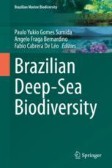Search
Search Results
-
Quantitative Distribution of the Flying Fish (Exocoetidae), Marine Mammals, Birds, and Sea Turtles in the Northern Part of the Central Atlantic Ocean (Results Obtained in the Research Cruises nos. 43–45 of the R/V “Akademik Nikolaj Strakhov”)
AbstractThe results of visual assessments of the flying fish (Exocoetidae), marine mammals, birds, and sea turtles, carried out mainly in the...

-
Discovery of Poromitra macrophthalma (Melamphaidae) in the Atlantic Ocean
AbstractThe occurrence of big-eyed rhinofish Poromitra macrophthalma in the central part of the Atlantic Ocean is reported for the first time. This...

-
Evidence for a single population expansion event across 24,000 km: the case of the deep-sea scavenging amphipod Abyssorchomene distinctus
Anthropogenic activities such as mining pose a putative threat to deep-sea ecosystems and baseline studies of key indicator species are required to...

-
High diversity and pan-oceanic distribution of deep-sea polychaetes: Prionospio and Aurospio (Annelida: Spionidae) in the Atlantic and Pacific Ocean
Prionospio Malmgren
1867 and Aurospio Maciolek1981 (Annelida: Spionidae) are polychaete genera commonly found in the deep sea. Both genera belong to...
-
Living and Non-living Resources in Brazilian Deep Waters
In Brazil, deep-sea marine environments extend over 3.5 million km2, covering nearly 80% of Brazil’s Economic Exclusive Zone (EEZ) in the southern...
-
46 Conservation of Cold-Water Corals in the Mediterranean: Current Status and Future Prospects for Improvement
The Mediterranean deep-sea contains a mosaic of ecosystems and habitat types. Among them, cold-water corals provide shelter to a large and unique...
-
Errina argentina sp. nov., a new stylasterid (Hydrozoa: Stylasteridae) from Mar del Plata submarine canyon (Southwest Atlantic)
Errina is a cosmopolitan genus of arborescent stylasterids that includes, discounting Errina cyclopora incertae sedis, 26 recent species and one...

-
An organ of equilibrium in deep-sea isopods revealed: the statocyst of Macrostylidae (Crustacea, Peracarida, Janiroidea)
Isopoda ( Crustacea , Peracarida ) from the deep sea are relatively well studied but little is known about their lifestyles or the functional morphology...

-
First record of the deep-sea isopod family Dendrotionidae (Isopoda: Asellota) from the Northwest Pacific with description of two new species of Dendromunna
Two new abyssal species of Dendrotionidae are described: Dendromunna kurilensis sp. nov. from the Northwest Pacific Basin to the east of the...

-
Deep-Sea Suprabenthic Communities: The Forgotten Biodiversity
Suprabenthos includes all swimming bottom-dependent animals (mainly small peracarid crustaceans) living in the water layer just above the sea floor....
-
Factors Determining the Distribution of Arachnida
As factors of distribution of Arachnida are outlined paleogeography and paleodistribution, age of groups, barriers, bridges, ability to overcome...
-
Distributional patterns of isopods (Crustacea) in Icelandic and adjacent waters
Since the 1990s, the marine benthos of the Greenland–Iceland–Faeroe (GIF) Ridge has been sampled through the BIOICE (Benthic Invertebrates of...

-
Deep-Sea Suprabenthic Communities: The Forgotten Biodiversity
Suprabenthos includes all swimming bottom-dependent animals (mainly small peracarid crustaceans) living in the water layer just above the sea floor....
-

-
Harpacticoid copepods are successful in the soft-bottom deep sea
Different taxa have had different degrees of success in invading and proliferating in the deep sea. The reasons for these differences are not well...
-
A review of the distribution of hydrothermal vent communities along the northern Mid-Atlantic Ridge: dispersal vs. environmental controls
Until 1985, seven vent fields were described from the Mid-Atlantic Ridge (MAR). An eighth field, Mount Saldanha (36° N), discovered in 1998, showed...
-
A review of the distribution of hydrothermal vent communities along the northern Mid-Atlantic Ridge: dispersal vs. environmental controls
Until 1985, seven vent fields were described from the Mid-Atlantic Ridge (MAR). An eighth field, Mount Saldanha (36° N), discovered in 1998, showed...
-
Bacterial flora from echinoderm guts and associated sediment in the abyssal Vema Fault
Individuals of the asteroid Solaster sp. and the holothurian Pseudostichopus villosus (Theel) were collected from deep-sea bottom of the Vema fault...
-
Early History and Biogeography of South America’s Extinct Land Mammals
South America’s peculiar extinct mammalian fauna has been a source of fascination since the late 1700’s when a Pleistocene skeleton of the giant...
-
A critical evaluation of the application of amino acid racemization to geochronology and geothermometry
In this review we have critically evaluated the application of the diagenetic racemization of amino acids to geochronology and geothermometry....
